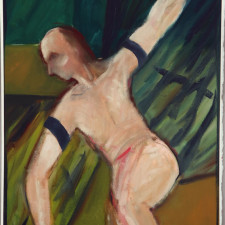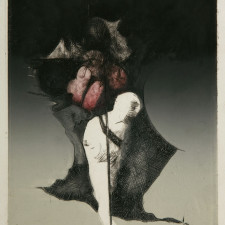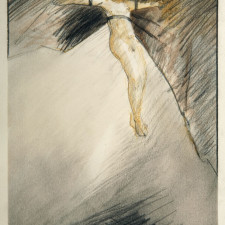Press Cuttings Artist’s Second One-man Exhibition Shows Improvement
When John Kelly – a house-painter by trade who has been studying art in the evening – held his first one-man show in the Ritchie Hendriks gallery, St. Stephen’s Green, Dublin about two years ago, I remarked that his feelings seemed to be a bit too strong for his talent. To a large extent that criticism holds good for his second one-man show currently on view at the same gallery though he has acquired a good deal of assurance, and a lot more technique, in the interim. He is still primarily interested in religious subjects, but this show also includes a couple of landscapes and some Spanish studies. His visit to Spain has brought a new range of sandy browns and reds into his palette and his instinct for colour remains as sound as ever. “The Outcast”, a forlorn figure behind a lattice work of red and grey, is a powerful piece of painting; so is “The Prisoner”, a variation on the same theme, in which resignation is very economically conveyed in the dejected slump of the man, and the way his arms are folded.
Of the religious paintings, “The Last Supper” is interesting for its original shape and viewpoint. The frame is a vertical oblong; the figure of Christ is seated in the immediate foreground, breaking a loaf of bread, with a glass of wine to hand; the disciples appear ranged behind, almost in the form of a stained glass window; and the colours are confined, with rather naïve but surprisingly effective symbolism, to reds and whites. “Magdalen”, painted in a brooding, earthy shade of red, is another fine religious painting; then there is “The Raising of Jairos’ Daughter” in which the Christ figure has been enlarged to the proportions of a giant, and the girl appears dwarfed; and “The Fourth Station” in which a vivid blue, which has almost the luminosity of a stained glass window, catches the eye.
Of the non-religious paintings, “Outside a Spanish Town” shows a great deal of assurance and a very competent technique; “The Goat Man”, painted entirely in tones of brown and orange – surely another legacy of the Spanish trip? – is equally effective; and there is great atmosphere in “The Night Workers”, with it hollow-eyed men returning from work in the first electric-blue light of dawn. “I Will Go Now” which carries a hint of the W.B.Yeats poem in the title, and more of a hint of Jack B.Yeats’s style in the painting, shows that he is beginning to get away from the strong primary colours which dominated his first exhibition.
Like that earlier show, this is a promising exhibition, though it, too, contains a lot of uneven work and a good deal of clumsy drawing; however the intensity of his feeling carries the viewer over the bumpy patches.
The show continues until the end of the month.
G.H.G., The Irish Times, 07.03.1959




